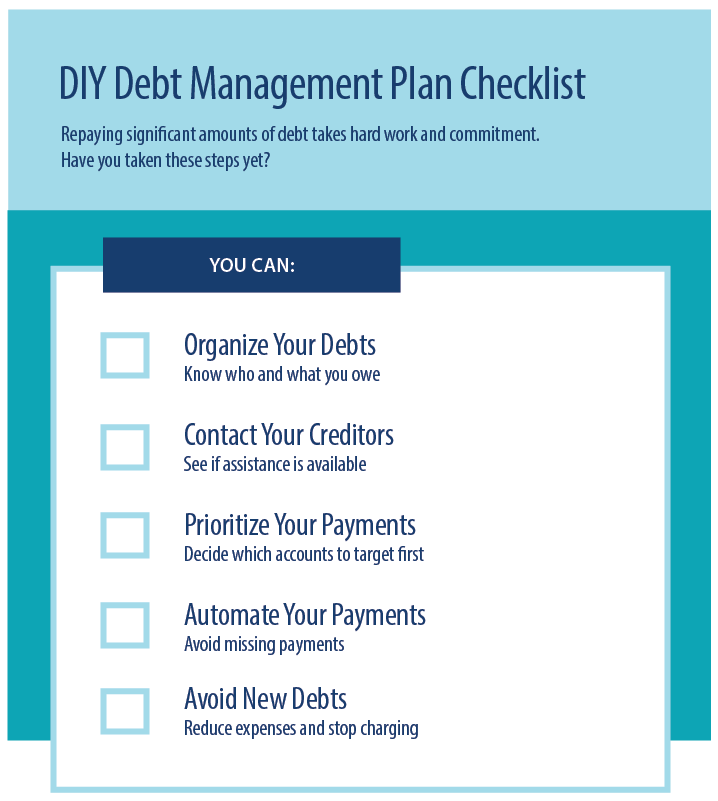Just How Debt Combination Can Simplify Your Financial Life: More Discussion Posted Here
Just How Debt Combination Can Simplify Your Financial Life: More Discussion Posted Here
Blog Article
Everything You Need to Understand About Producing a Personalized Financial Obligation Management Plan
In the world of individual financing, devising a tailored financial debt monitoring strategy is often the cornerstone of achieving economic security and peace of mind. As you navigate the complexities of creating a tailored financial obligation monitoring strategy, understanding the details of each step is crucial to your financial success.
Evaluating Your Current Financial Obligation Situation
One must initially carry out an extensive assessment of their current financial obligation commitments prior to developing an efficient financial debt administration plan. Assessing your current debt circumstance is an essential primary step in obtaining control of your funds. Begin by collecting all essential economic files, such as charge card statements, funding agreements, and any kind of superior costs. Create a detailed checklist of each debt, including the complete amount owed, rate of interest rates, minimal regular monthly settlements, and due dates. This extensive introduction will provide a clear image of your monetary standing and help prioritize which debts to resolve initially.
After compiling this info, calculate your complete debt-to-income proportion by separating your monthly financial debt repayments by your monthly income. This ratio is a key indication of your capacity to take care of present financial obligation degrees properly. Furthermore, assess your credit scores report to determine any mistakes or inconsistencies that may be influencing your debt rating. Comprehending these facets of your economic circumstance will certainly lead you in developing a customized financial debt monitoring plan tailored to your certain needs and goals.
Setup Financial Goals and Targets

When setting financial goals, it is very important to be particular, quantifiable, attainable, appropriate, and time-bound (WISE) For instance, you might set a goal to pay off a particular amount of financial obligation within a specific amount of time, such as minimizing your credit card balance by $5,000 in the following twelve month - More Discussion Posted Here. By setting clear targets such as this, you can track your progress and stay motivated to achieve your financial obligation monitoring objectives
In addition, consider prioritizing your debts based on elements such as rates of interest, impressive balances, and payment terms. By concentrating on high-interest financial obligations initially, you can conserve money in the long run and increase your trip toward financial liberty. Keep in mind, everyone's economic circumstance is one-of-a-kind, so customize your objectives and targets to fit your specific needs and conditions.
Creating a Realistic Spending Plan
Crafting a well-defined budget plan is an essential action in reliable debt administration and financial preparation. A realistic spending plan serves as a roadmap for your monetary wellness, helping you track your earnings, costs, and debt settlements. To create additional info a functional budget, beginning by noting all your resources of revenue.
When setting budget limitations, be truthful with on your own concerning your costs routines and economic commitments. Designate a portion of your earnings towards paying off financial debt while ensuring you have some funds for cost savings and emergency situations. Regularly testimonial and adjust your spending plan as required to remain on track with your monetary goals and financial debt settlement strategy. By sticking to a realistic spending plan, you can efficiently manage your financial obligation and work towards a much more safe monetary future.
Discovering Debt Payment Approaches
After developing a reasonable budget, the next vital action in reliable debt administration is to check out different financial debt repayment approaches. One usual method is the snowball approach, where you concentrate on settling the tiniest debts first while making minimum payments on larger debts. This technique can help construct energy as you see smaller sized financial debts being removed, giving inspiration to deal with larger ones.
An additional technique is the avalanche approach, which includes focusing on financial obligations with the highest possible rate of interest. By targeting high-interest financial debts first, you can lower the overall quantity you pay in interest with time. This method might be much more cost-efficient over time, despite the fact that it might take longer to see specific financial obligations fully settled.
Debt combination is one more option where you combine multiple financial obligations right into a solitary car loan with a lower rate of interest rate. This can streamline your repayment process and potentially lower the complete interest paid. Nevertheless, it's vital to thoroughly think about the costs and terms connected with debt consolidation to ensure it's the right choice for your financial scenario.
Monitoring and Changing Your Plan

Changing your plan may include reallocating funds to take on high-interest financial obligations first, negotiating with lenders for lower passion rates or much better payment terms, or discovering added revenue resources to speed up financial obligation settlement. As your financial situation evolves, your debt management strategy ought to adjust appropriately to stay efficient. By staying adaptable and aggressive in monitoring and readjusting your plan, you can enhance your initiatives in the direction of paying off your financial debts efficiently and accomplishing your financial goals.
Verdict
In conclusion, creating a tailored financial debt management plan includes assessing current debt, establishing economic goals, producing a practical budget, checking out repayment approaches, and monitoring and readjusting the plan as required. By complying with these steps, individuals can take control of their financial circumstance and job towards ending up being debt-free. It is vital to remain disciplined and dedicated to the plan in order to achieve long-lasting economic stability.
One have to initially carry out a comprehensive evaluation of their present financial debt commitments before formulating an efficient financial obligation monitoring strategy.After developing a realistic budget plan, the following crucial action in efficient debt administration is to discover different financial debt settlement strategies - More Discussion Posted Here.To properly manage your financial debt, constant tracking and adjustment of your debt administration strategy are vital elements for long-term economic stability.Changing your plan might entail reapportioning funds to tackle high-interest debts first, working out with financial institutions for lower rate of interest rates or better repayment terms, or exploring extra income sources to quicken financial obligation payment.In verdict, producing a personalized go right here debt management strategy entails evaluating present financial obligation, setting economic goals, producing a realistic budget, exploring settlement strategies, and monitoring and readjusting the strategy as needed
Report this page